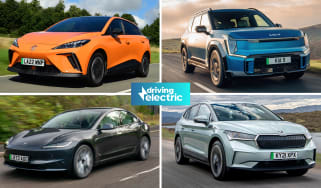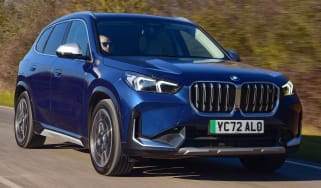New electric cars coming in 2023 and beyond
With electric cars making up an ever-increasing proportion of sales, the industry is working flat out to launch new models – here's what's on the way soon

Electric cars have never been more popular, with more than 260,000 of them sold in the UK last year. In fact, as of September 2023, EVs now account for more than 20% of new car sales, with the Society of Motor Manufacturers and Traders claiming one EV is sold in Britain every 60 seconds.
Thus, with the 2030 ban on the sale of new petrol and diesel cars looming, manufacturers are developing and launching waves of new electric cars of all varieties, from city cars and hatchbacks to seven-seat SUVs and luxurious limousines, as established automotive brands go head-to-head with recently founded startups.
Here, we take a look at some of the hottest and most interesting new electric cars hitting the street in 2023 and beyond…

AEHRA electric SUV
If you didn’t think there were enough posh electric SUVs on sale yet, AEHRA is a new Italian manufacturer that’s aiming to “rewrite the automotive design rulebook” with its upcoming plug-in 4x4. Expected to be priced well over £150,000, the AEHRA SUV is set to hit the market in 2025 boasting a striking curved design, gull-wing doors (like the Tesla Model X) and a range of up to 497 miles.
Find out more about the AEHRA luxury SUV here.

Afeela electric saloon
No, Afeela isn’t the name of the next epidemic disease, it’s a new electric-only brand formed by Honda and tech giant Sony. Set to go on sale in 2026, a concept of the yet-to-be-named saloon was showcased at the Consumer Electronics Show (CES) in Las Vegas. The Afeela wowed the crowds with its panoramic infotainment screen that spans the entire dashboard, as well as its futuristic styling and dual-motor powertrain.
Find out more about Afeela's forthcoming electric soon here.
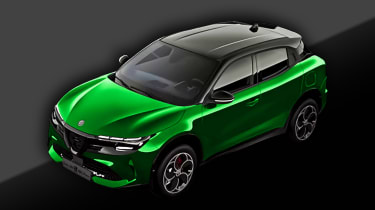
Alfa Romeo Brennero
It’s fair to say that in 2023, Alfa Romeo is pretty late to the EV party, having yet to launch a single electric model. We won’t be waiting much longer for one, though, as Alfa’s first EV has leaked online in the form of a small zero-emissions SUV. Almost certain to share its hardware with the Jeep Avenger and Vauxhall Mokka Electric, expect the plug-in Italian crossover to offer a range of around 250 miles. Power will likely come from a modest front-mounted 154bhp electric motor, though Alfa Romeo has assured us that its latest model, thought to be badged ‘Brennero’, will still offer the same sporty driving characteristics as the larger hybrid-powered Tonale.
Find out more about the alfa Romeo Brennero here.
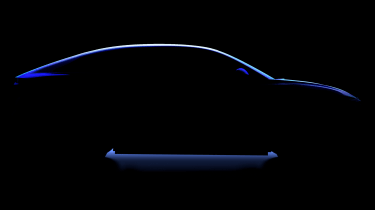
Alpine GT X-Over
Alpine, the performance-car offshoot of Renault, has announced plans to launch a total of five EVs by 2028, including three electric SUVs. The first is its answer to the Ford Mustang Mach-E, BMW iX1 and Kia EV6 called the Alpine GT X-Over, which is set to enter production in 2025. It will sit on the same 'CMF-EV' platform as the Nissan Ariya, but the GT X-Over is expected to use a new triple-motor setup, for four-wheel drive and a power output in the 400-500bhp range. Find out more about the Alpine GT X-Over here.
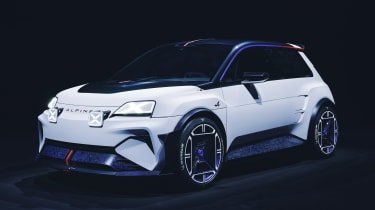
Alpine A290
Alpine’s EV line-up won’t consist entirely of SUVs, however. Its first electric car will be a hot hatch based on the forthcoming Renault 5 (profiled further down). The Alpine R5 is due to hit the road in 2024, will be front-wheel drive only and use a single electric motor that’s expected to produce 215bhp. Other than that, technical details remain firmly under wraps, and styling-wise, the single teaser image Alpine has released of the R5 so far only indicates it’ll get a sizeable rear wing.

Find out more about the Alpine A290 here.
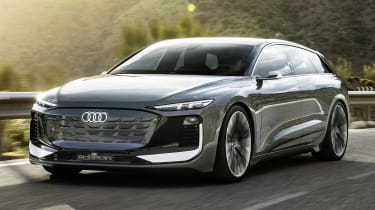
Audi A6 e-tron
The Audi A6 e-tron electric saloon will join the German brand’s e-tron-badged range of electric cars in 2023, followed just a year later by an estate version. The production versions of the A6 e-tron and A6 Avant e-tron (above) concepts will use the new 'Premium Platform Electric' (PPE) Audi co-developed with Porsche. Audi says the A6 e-tron models will boast a range of up to 435 miles, with the most potent variants capable of sprinting from 0-62mph in less than four seconds thanks to dual-motor setups for quattro all-wheel-drive.
Find out more about the Audi A6 e-tron here.
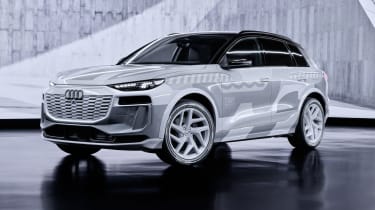
Audi Q6 e-tron
The Q6 e-tron SUV will be the next addition to Audi’s zero-emissions line-up, expected to arrive in showrooms in 2023. The Q6 e-tron and its sister model the electric Porsche Macan will be the first production EVs to sit on the new 'PPE' (Premium Platform Electric), with the Audi introducing the maker’s latest generation of car interior, complete with three individual screens and a plethora of recycled materials. A range of around 300 miles can be expected, as well as a 500bhp power output – possibly boosted further in an 'RS' performance model.
Find out more about the Audi Q6 e-tron here.
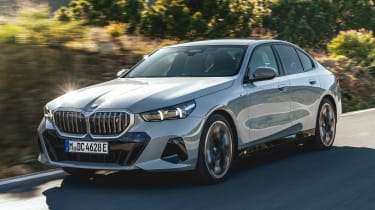
BMW i5
BMW’s electric car lineup continues to grow and the i5 has landed as perhaps the most highly-anticipated model yet. Sharing its looks, tech and underpinnings with the new petrol-powered 5 Series, the i5 has a range of up to 362 miles – just enough to keep up with its main rival, the Mercedes EQE. Packing the futuristic ‘Interaction Bar’ interior trim from the i7 limousine, the i5 is now on sale from just over £74,000, with first customer deliveries expected in October 2023.
Find out more about the BMW i5 here.

Chevrolet Corvette EV
The first “electrified” version of the Chevrolet Corvette sports car was unveiled in January 2023. Called the Corvette E-Ray (above), it pairs a 6.2-litre naturally-aspirated V8 with an electric motor on the front axle for four-wheel drive, 646bhp on tap and a 0-60mph time of just 2.5 seconds. However, it’ll be joined in time by a fully electric model wearing the iconic nameplate – likely to the dismay of petrol-drinking Americans. The zero-emissions Corvette will use the same Ultium battery technology and platform as electric versions of the Chevrolet Silverado pickup, as well as the Hummer EV and Cadillac Lyriq.
Find out more about the electrified Corvette here.
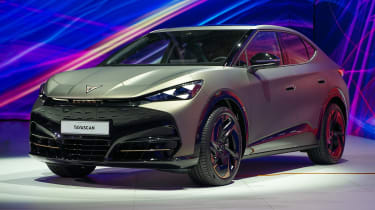
Cupra Tavascan
The Cupra Tavascan has been unveiled as a sportier, Spanish take on the Volkswagen ID.5 and Skoda Enyaq Coupe. It uses the same MEB running gear as those cars, with the choice of a single or dual-motor powertrain. Particular highlights include illuminated Cupra badging, figure-hugging sports seats and a rather striking design. A 77kWh battery provides a range of up to 341 miles, while top models can reach 62mph in as little as 5.6 seconds.
Find out more about the Cupra Tavascan here.
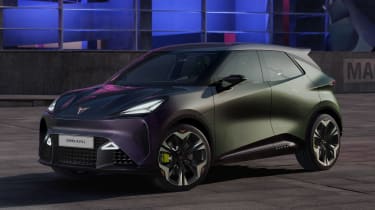
Cupra Raval
Cupra, Skoda and Volkswagen are all launching affordable electric cars in 2025, based on the same mechanical platform. But, Cupra has been the first to provide us with a clear look yet at its entry-level EV: the Raval. The compact four-door EV concept you see here is about 95% representative of the car that’ll arrive in showrooms in a couple of years. Cupra CEO Wayne Griffiths previously hinted that the entry-level EV would cost just over €20,000 (around £17,600 at today’s exchange rate) – despite offering a range of up to 273 miles.
Find out more about the Cupra Raval here.

Dacia Spring
Move aside BYD Dolphin, the Dacia Spring is on its way to become Britain’s cheapest electric car. Already on sale in Europe, the Spring is likely to cost from under £20,000 when it arrives on this side of the channel. It may feel pretty cheap inside – watch our video review for evidence of that – but an electric range of up to 143 miles should make the electric Dacia ideal for city-based buyers looking for a cheap commuter vehicle. UK specs will differ from the current EU specifications, though, with Dacia promising “significant improvements in design and equipment” – hopefully including making DC rapid charging a standard feature.
Find out more about the Dacia Spring here.
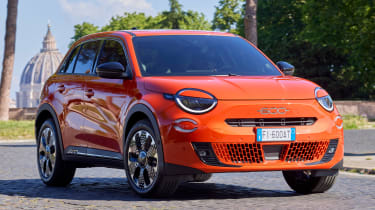
Fiat 600e
Is the Fiat 500e just a little too small for your needs? Well, Fiat has heard your cries as the new 600e SUV boasts all the funkiness of its smaller sibling, but with far more passenger and boot space. Despite having a 249-mile range and a long list of standard equipment, the Fiat 600e will undercut most of the competition when it goes on sale late in 2023. While Fiat says the 600e has been designed specifically for urban motoring, we can expect a sporty Abarth version to arrive in the future, too.
Find out more about the Fiat 600e here.
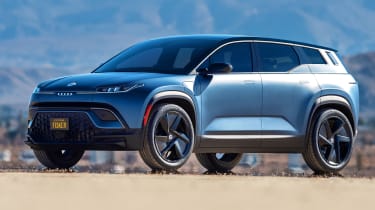
Fisker Ocean
The Ocean is a zero-emissions SUV that'll rival the likes of the Tesla Model Y, Audi Q4 e-tron, BMW iX3, Ford Mustang Mach-E and Toyota bZ4X. While top models are able to cover a staggering 440 miles on a charge, an entry-level version will follow in the next year or so, with prices slated to start from £34,990. Inside, there’s a slim digital driver’s display behind the two-spoke steering wheel, while the dashboard is dominated by a 17.1-inch central infotainment touchscreen that's portrait-orientated when you’re driving, but can rotate 90 degrees into 'Hollywood' mode when parked, so you can watch a movie while topping up the battery.
Find out more about the Fisker Ocean here.
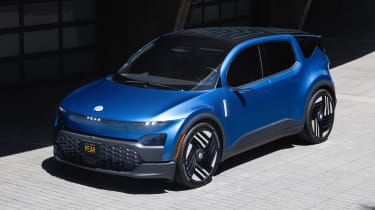
Fisker PEAR
Fisker’s second EV is an affordable electric city car called the PEAR – an acronym for 'Personal Electric Automotive Revolution'. The PEAR will be available with single and dual-motor setups for a choice of rear or all-wheel drive, plus two battery options, with the larger Hyper Range pack quoted to have a range of up to 348 miles. The PEAR measures 4.5 metres end-to-end – about the same as a Kia Sportage – and according to CEO Henrik Fisker, it could start from close to £25,000 when it lands in the UK.
Find out more about the Fisker PEAR here.

Fisker Ronin
In addition to its pair of electric SUVs, Fisker has revealed it’s working on a four-seater convertible GT car with a range of approximately 600 miles. CEO and founder Henrik Fisker shared the news on social media, adding that the Ronin will be capable of 0-60mph in close to two seconds, thanks to its three electric motors. Development of the Tesla Roadster and Maserati GranCabrio Folgore rival is already underway, with prices expected to start from under $200,000 (just under £160,00 at the time of writing) when it goes into production in 2024.
Find out more about the Fisker Ronin here.
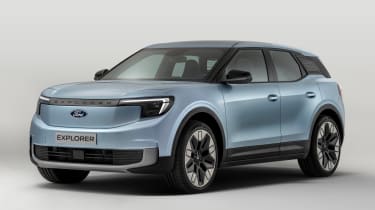
Ford Explorer
After a long history in the US and a brief stint in the UK during the early 2000s, the Ford Explorer nameplate is back, worn by a medium-sized electric SUV, based on the Volkswagen ID.4. Despite sharing its basic platform and battery technology with the VW, which allows for a range of up to 335 miles, the Ford has its own character, with a brutish, distinctly American design and sliding centre touchscreen. Delayed in order to meet new EU safety regulations, the Explorer will go on sale in summer 2024, with prices expected to start from just over £40,000.
Find out more about the Ford Explorer here.

Ford Puma EV
Ford has confirmed an electric version of its hugely popular Puma compact SUV will arrive in 2024, after the Explorer family SUV (above) and a "sports crossover". We know the Puma EV will roll off the same Romanian production line as the existing petrol-powered model, but technical details have yet to be revealed. It won't use the same platform as Volkswagen's ID. electric models though, which will serve as the underpinnings for the other two electric SUVs Ford has in the works.
Find out more about the Ford Puma EV here.

Hyundai Ioniq 5 N
The Hyundai Ioniq 5 N is the first electric model to wear the Korean maker’s N performance badge, and is due on sale in 2024. Packing a muscular 641bhp dual-motor powertrain, the electric N hot hatch has been engineered to feel as similar to its petrol-powered siblings as possible. The new ‘N e-shift’ system is designed to replicate the sound and feel of a combustion engine and gearbox, while there are also several other track-focused features to make the souped-up Ioniq 5 more fun to drive in anger. Expected to cost from around £60,000, the Ioniq 5 N looks to be one of the most driver-focused EVs yet.
Find out more about the Hyundai Ioniq 5 N here.

Jeep Recon 4x4
The Jeep Recon 4x4 looks to be a zero-emissions alternative to the brand’s iconic Wrangler, and will be offered exclusively with electric power when it comes to the UK in 2025. The electric off-roader has been designed to go off the beaten track, coming equipped with Jeep’s Selec-Terrain traction management system, under-body protection, tow hooks and aggressive off-road tires. It’ll also come with all-wheel drive and use the brand-new STLA Large platform that it’ll share with the electric version of the Jeep Wagoneer coming soon (profiled below).
Find out more about the Jeep Recon 4x4 here.
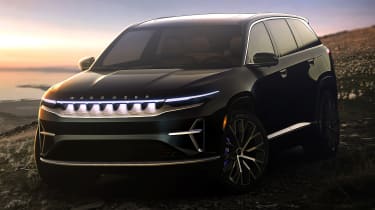
Jeep Wagoneer EV
The final Jeep EV confirmed so far is an electric version of the brand’s flagship Wagoneer SUV that’s due to arrive in 2024. Currently code-named the Wagoneer S, Jeep says it’s targeting a range of 400 miles on a single charge for this large electric range-topper. It will also be capable of 0-60mph in around 3.5 seconds and produce over 590bhp. Like the Recon 4x4, it’ll use the new EV-dedicated STLA Lage platform and be built in North America.
Find out more about the electric Jeep Wagoneer here.
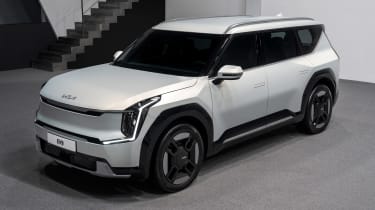
Kia EV9
Kia has unveiled its all-new flagship electric SUV: the seven-seater EV9 – and we’ve already driven it. Sitting alongside the hybrid-powered Sorento in the brand’s lineup, the EV9 features a distinctive boxy design and a minimalist concept car-esque interior. Kia has confirmed the EV9 will do up to 336 miles on a single charge and will be offered with both single and dual electric motor powertrains. Due to go on sale in 2024 with prices starting from just under £65,000, the EV9 is more expensive than entry-level versions of the Mercedes EQB, but offers much more space and electric range. It should be much cheaper the the forthcoming Volvo EX90 and electric Range Rover, though
Read our in-depth Kia EV9 review here.
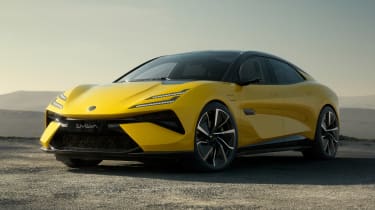
Lotus Emeya
The Lotus Emeya is Britain’s answer to the Porsche Taycan, Tesla Model S and Lucid Air. Dubbed by Lotus as its first “electric hyper GT”, the Emeya lives up to its billing with its 893bhp powertrain and 0-62mph time of under 2.8 seconds. Active aerodynamics – including a deployable rear spoiler – provide up to 215kg of downforce and should make the Emeya as fast to drive on a twisty road as it is in a straight line. Yet, despite its insane performance and tech-filled interior, the Emeya is still capable of well over 300 miles on a charge. It’ll go on sale next year, although it’s unlikely Lotus’ new electric flagship will cost anything less than £100,000.
Find out more about the Lotus Emeya here.
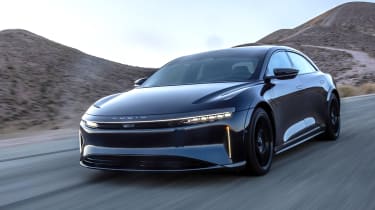
Lucid Air
Frequently dubbed the ‘Tesla Model S killer’, the Lucid Air is another fast and luxurious electric saloon from another American start-up. With entry-level Lucid Air Pure models starting from $87,400 in the US (just over £70,000 at the current exchange rate), the electric saloon has a maximum range of almost 550 miles, making it the longest-range electric car to ever go on sale. On the inside, the Lucid is wrapped in luxurious sustainable materials and features a wraparound instrument cluster and two large centre screens. A right-hand drive model has been confirmed and it’s already on-sale in Germany, but it remains to be seen when the Lucid Air will arrive in the UK.
Find out more about the Lucid Air here.
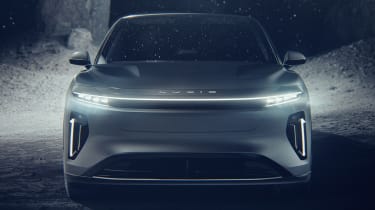
Lucid Gravity
Lucid's next EV is a luxury seven-seater electric SUV called the Gravity. We've already got our first look at the future Tesla Model X and Mercedes EQS SUV rival, but it'll be fully unveiled later in 2023. The Gravity sits on the same LEAP (Lucid Electric Advanced Platform) platform as the Air and is expected to be offered with a similar variety of powertrains to the saloon. Lucid has stated the Gravity will boast “supercar levels of performance” and “more range than any other EV” outside the company’s own lineup.
Find out more about the Lucid Gravity here.
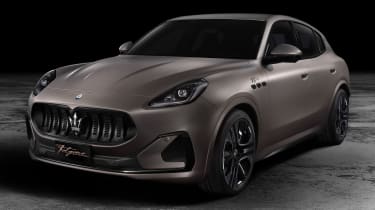
Maserati Grecale Folgore
The Maserati Grecale Folgore is Italy’s answer to the electric Porsche Macan and BMW iX3. The premium electric SUV will arrive in showrooms in 2023, produce around 540bhp and 800Nm of torque, and feature a 105kWh battery, meaning it could cover close to 400 miles on a charge. You can already get a Folgore-badged version of the Gran Turismo sports car, but by 2025, Maserati’s EV line-up will also include a zero-emissions version of its recently released MC20 supercar, as well as the next iterations of the Levante SUV and Quattroporte saloon, which will both be EV-only.
Find out more about the Maserati Grecale Folgore here.

Mercedes EQG
The Mercedes G-Class is not the first car you’d think might be in-line for the EV treatment, but in 2024 a fully electric version of the legendary 4x4 will go into production. It’ll be called the Mercedes EQG, and will use a modified version of the current G-Class’ platform. The EQG’s four individual motors will allow for what Mercedes has called a ‘G-Turn’; this involves the wheels either side spinning in opposite directions, enabling the EQG to rotate like a tank.
Find out more about the Mercedes EQG here.
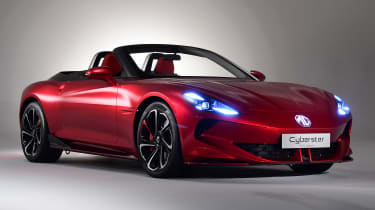
MG Cyberster
MG has a storied history of making great sports cars, but recently the now-Chinese-owned marque has focused on making value-focused family cars. That is, until now, as the hotly-awaited MG Cyberster has been revealed and is expected to go on sale in 2024. Featuring scissor doors, a convertible roof and a yoke-style steering wheel, the Cyberster certainly stands out against other MGs of late – and will be offered with as much as 536bhp.
Find out more about the MG Cyberster here.
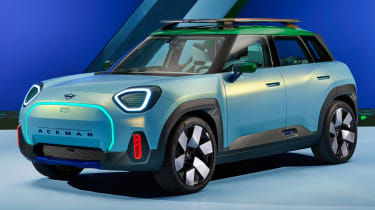
MINI Aceman
MINI is preparing to launch an all-new, five-door electric crossover in 2024, previewed by the Concept Aceman. The production Aceman will use the brand-new platform from the new MINI Cooper Electric, which has been designed exclusively for EVs and should help maximise cabin and luggage space in the compact crossover. Although, range and performance figures for the Aceman are still under wraps, we expect it’ll be able to cover at least 250 miles on a charge.
Find out more about the MINI Aceman here.
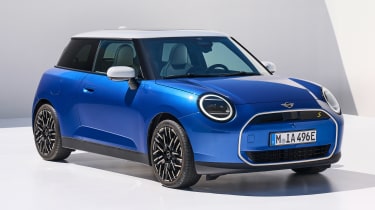
MINI Cooper Electric
The new MINI Cooper has arrived as the replacement for the old MINI Electric and looks to be an improvement in almost every way. Two models will be available at launch: a standard car with a starting price of around £30,000 and a range of almost 200 miles, plus the top-of-the-range MINI Cooper SE with 218bhp and a range of 250 miles. Featuring a revolutionary new interior with futuristic and playful customisation options, the new MINI Cooper Electric will be built in Britain from 2026 and is set to go on sale in the spring of 2024.
Find out more about the MINI Cooper Electric here.
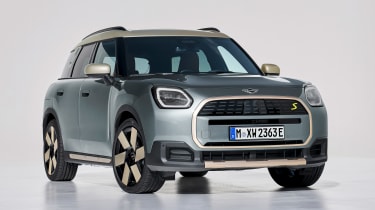
MINI Countryman EV
The new third-generation MINI Countryman uses the same underpinnings as the latest BMW X1 and fully electric iX1, and is being offered with a similar choice of petrol or electric power. It gets the smaller Cooper Electric’s snazzy minimalist interior and circular touchscreen, but also boasts its own ‘Experience Mode’, dubbed ‘Trail’. Boasting a range of up to 287 miles and a choice of two electric motor setups, the plug-in Countryman will go on sale next year, with prices confirmed to start from just over £40,000.
Find out more about the MINI Countryman EV here.
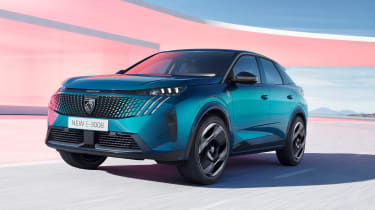
Peugeot e-3008
The Peugeot e-3008 is the French maker’s first bespoke EV and introduces the latest version of its futuristic i-Cockpit interior. Adopting a sleek coupe-SUV silhouette, the electric 3008 acts as a replacement for the old petrol model and gets a curved triple-screen infotainment setup and will be available with three distinct battery and electric motor configurations. Perhaps most impressive is the ‘230 Long Range’ model which can, according to Peugeot, travel up to 435 miles on a single charge – 100 miles more than a Tesla Model Y. Base and ‘320 Dual-Motor’ cars will go on sale first, though, likely from just under £50,000.
Find out more about the Peugeot e-3008 here.
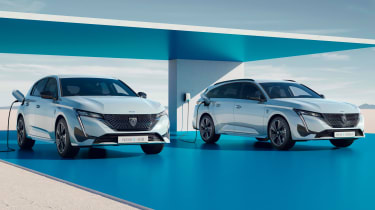
Peugeot e-308
In 2023, the latest Peugeot 308 family hatchback and estate will be available with electric power, badged as the e-308. Both models will use a 156bhp electric motor fed by a 54kWh battery, which according to Peugeot, should be enough for a range of 248 miles on a full charge. Meanwhile, 100kW rapid charging speeds mean a 20-80% top-up will take 25 minutes from the right charging-point. This powertrain is shared with the Vauxhall Astra Electric that’s now on sale (profiled below), as well as a zero-emissions version of the DS 4 that’s following in 2024.
Find out more about the Peugeot e-308 here.
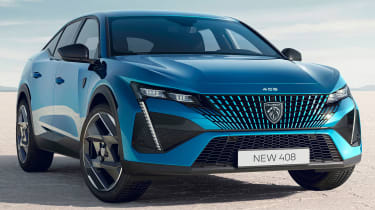
Peugeot e-408
Peugeot has also confirmed that it will be launching an electric version of its new 408 fastback saloon in 2023, which we expect to be called the e-408. Given that the 308 and 408 share the same platform, it’s reasonable to assume Peugeot’s future Polestar 2 and Hyundai Ioniq 6 rival will utilise the same 156bhp motor and 54kWh battery combination as the e-308 family hatchback and estate we already mentioned.
Find out more about the Peugeot e-408 here.
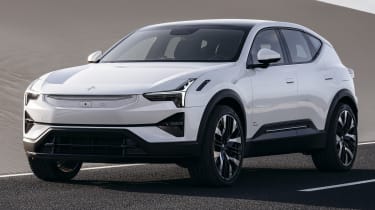
Polestar 3
The Polestar 3 is the Swedish brand's first electric SUV and rival to the BMW iX. Two versions are available at launch, both featuring a dual-motor powertrain and 111kWh battery that's good for a range of up to 379 miles, according to Polestar. Inside, the 3 gets an array of sustainable materials and driver assistance systems, plus a new 14.5-inch touchscreen. Prices start from just over £80,000 and while order books are now open, first deliveries aren’t expected until late 2023.
Find out more about the Polestar 3 here.
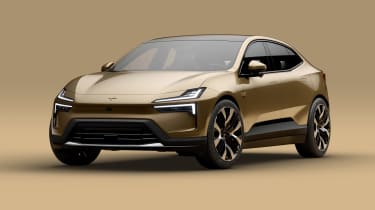
Polestar 4
If you couldn’t tell by the name, the all-new Polestar 4 is the Swedish brand’s aptly named fourth model that was revealed in early 2023. It’s an electric coupe-SUV that rides slightly higher than the more saloon-like Polestar 2 and, confusingly, is slightly smaller than the Polestar 3 SUV. Perhaps the Polestar 4’s most peculiar trait is its lack of a rear window, with cameras being used instead. Set to be offered with both single and dual-motor powertrains, we expect the Polestar 4 to start from around £50,000 when it eventually goes on sale.
Find out more about the Polestar 4 here.
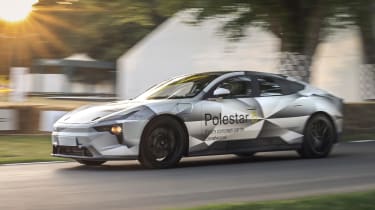
Polestar 5
After the Polestar 3 and Polestar 4, the electric-only brand will launch its pièce de résistance: a 872bhp four-door luxury GT flagship. The Polestar 5 is due to arrive in 2024 and will rival cars like the Mercedes EQS, Lucid Air and Tesla Model S. It’s currently being developed in the UK, and will have near-identical styling to that seen on the Precept concept car last year. It will also feature a dual-motor powertrain, plus a 800-volt electrical system like the Porsche Taycan.
Find out more about the Polestar 5 here.
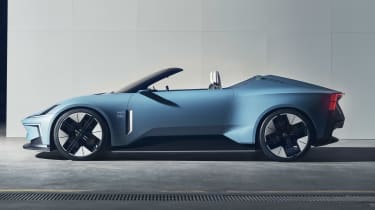
Polestar 6
Polestar has confirmed it will be putting its drop-top O2 concept into production as the Polestar 6. The Swedish brand’s “vision of a new era for sports cars” will be a direct rival to the upcoming second-generation Tesla Roadster, with design language and platform taken from flagship Polestar 5. It'll use the luxury saloon's 872bhhp dual-motor powertrain, with the Polestar 6 is targeting a 0-62mph time of just 3.2 seconds and a 155mph top speed. However, it's unlikely to go into production until 2026.
Find out more about the Polestar 6 here.

Porsche Boxster and Porsche Cayman
The next-generation Porsche 718 Cayman coupe and 718 Boxster convertible will ditch their combustion engines in favour of a zero-emissions powertrain, with the soon-to-be-electric-only sports cars set to arrive by 2025. Porsche’s top boss Oliver Blume has also revealed the pair will use a bespoke platform and their design will be influenced by the brand’s Mission R electric race-car concept from 2021.
Find out more about the Porsche Boxster/Cayman EVs here.

Porsche Macan electric
The new Porsche Macan is set to arrive in 2024, and will for the first time, be offered with a pure-electric powertrain. The Macan EV will use the new PPE platform that’ll underpin the Audi Q6 e-tron SUV we mentioned earlier and will be capable of faster charging speeds than the Porsche Taycan’s 270kW thanks to an 800-volt electrical system. We have also learned that the electric Macan will feature two electric motors – one on each axle – for a total power output of more than 600bhp and over 1,000Nm of torque.
Find out more about the upcoming electric Porsche Macan here.
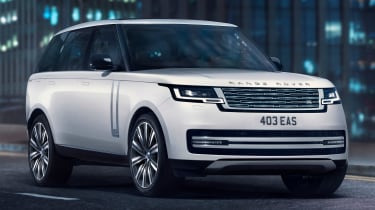
Range Rover EV and Range Rover Sport EV
The latest versions of the Range Rover (above) and Range Rover Sport are both available with plug-in hybrid power, and on a full battery can cover up to 70 miles without consuming a drop of petrol. But, in 2024, fully electric versions of the two luxury SUVs will be unveiled to the world. Sadly, no technical details on either model have surfaced so far, but likely rivals for the flagship Range Rover EV include the Mercedes EQS SUV and Lotus Eletre profiled above. Meanwhile, the Range Rover Sport EV will take on the BMW iX and Tesla Model X among others.
Find out more about the latest Range Rover here, and the new Range Rover Sport here.

Renault 4
Following the overwhelmingly positive reaction to the electric Renault 5 prototype (profiled below), the French brand is dipping into its back catalogue once again. In 2025 the iconic Renault 4 name will be reborn as a family-oriented compact electric SUV that'll rival the Smart #1 and Hyundai Kona Electric, among others. It'll be based on the same underpinnings as the new R5 and we expect it'll come with the same 134bhp electric motor, and 40kWh and 52kWh batteries, too. The Renault 4EVER Trophy concept (above) also indicates its design will pay homage to the original, with a particularly boxy design, relatively long bonnet and rounded front end.
Find out more about the Renault 4 here.
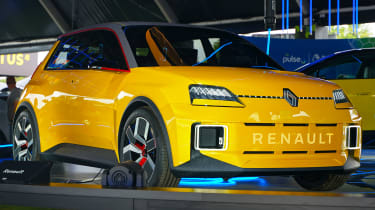
Renault 5
The reborn Renault 5 caused quite the stir online when it was unveiled in early 2021, so it came as no surprise when the reinvented and fully electric version of Renault's iconic hatchback was given the green light shortly after. It will sit on a brand-new platform and be offered with a choice of 40kWh and 52kWh batteries, the larger of which should offer around 250 miles of range. The electric Renault 5 is expected to start from around £20,000, and go head-to-head against the Fiat 500e, Honda e, next-generation MINI Electric and the production versions of the Cupra UrbanRebel and Volkswagen ID.2.
Find out more about the Renault 5 here.

Renault Scenic
The original Scenic MPV was essentially a roomier version of the Renault Megane hatchback, which disappeared from UK showrooms in 2021. It’s the same deal for the new electric Scenic, which has now been revived in SUV form. Boasting the same slick Google tech that clinched the Megane our Technology Award for 2023, the new Renault Scenic will be offered in both Standard Range and High Range forms. Keep your right foot in check and Renault says the Scenic (expected to cost from around £40,000) will be able to travel up to 385 miles before needing to be plugged-in, while its boot is said to offer an almost class-leading 545 litres of space.
Find out more about the Renault Scenic here.

Suzuki Jimny EV
Suzuki has declared it will launch its first electric car in Europe in 2024, and will introduce a total of five EVs to the continent by 2030. The Japanese brand hasn’t shared many details on what it’s working on, but it appears an electric version of its hugely popular Jimny compact SUV could be on its way based on this image from Suzuki’s European product plan for 2030. However, Suzuki hasn’t confirmed which of the five EVs it teased will be arriving first, or when the first model will even be unveiled.
Find out more about Suzuki's EV plans here.
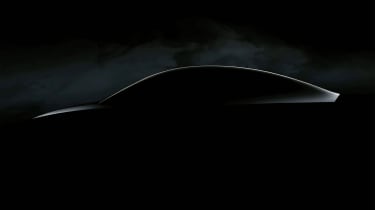
Tesla Model 2
The Tesla lineup will soon receive a big shakeup, with a facelifted version of the Model 3 having just been revealed with more range and a revised look. However, even more exciting is the impending arrival of the Model 2 hatchback, which is rumoured to start from just £25,000. Acting as a direct rival to the MG4, Tesla’s next model isn’t expected to arrive before 2025, but it’s certainly got people talking about Elon Musk’s EV brand again.
Find out more about the Tesla Model 2 here.

Tesla Model 3 facelift
Move over Model Y, the focus is back on the Tesla Model 3 saloon thanks to a comprehensive mid-life update. Set to go on sale in 2024, the facelifted Model 3 gets a sleeker front-end design reminiscent of the upcoming Tesla Roadster supercar, as well as an upgraded interior with plusher materials and a new screen for the rear passengers. Range has increased, too, with Long Range cars now able to cover up to 421 miles before you need to find one of Tesla’s many Superchargers. Despite the upgrades we expect pricing to stay roughly the same, with the pre-facelift Model 3 starting from around £43,000.
Find out more about the facelifted Tesla Model 3 here.

Volkswagen ID.1
The Volkswagen ID.1 is the German brand’s forthcoming entry-level electric car. The Polo-sized EV is set to go into production in 2025 alongside a crossover model called the ID.2, plus similar models from both Skoda and Cupra. All will use a smaller version of the group’s MEB electric-car platform, with prices expected to start from under £20,000 for the ID.1. Based on the teaser image Volkswagen released of the VW’s entry-level EV, it’ll also have very similar styling to its larger ID.3 hatchback sibling.
Find out more about the Volkswagen ID.1 here.
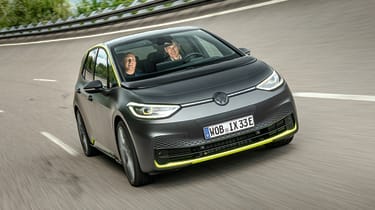
Volkswagen ID.3 GTX
Volkswagen is launching a high-performance version of the ID.3 electric hatchback that will be, to all intents and purposes, a zero-emissions Golf GTI. The fully electric hot hatch is likely to use the same dual-motor powertrain as the ID.4 GTX and ID.5 GTX we’ve already tested, as well as ID. Buzz GTX Volkswagen has also teased. If correct, that’ll mean nearly 300bhp on tap, all-wheel drive and a 0-62mph time of around six seconds.
Find out more about the ID.3 GTX here.
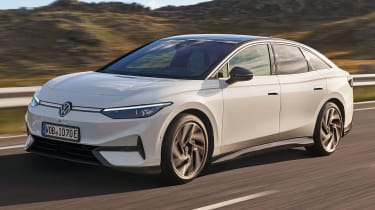
Volkswagen ID.7
Volkswagen has unveiled its answer to the Tesla Model 3 and Hyundai Ioniq 6: the swoopy ID.7 saloon. The headline figure is that Volkswagen says the ID.7 can travel up to 435 miles on a charge – significantly more than all of its rivals, including the Polestar 2. On the inside, the ID.7 gets VW’s latest minimalist interior design, with an updated infotainment system. Pricing is yet to be announced but you can bet the new electric people’s car will start from over £45,000 when it goes on sale later in 2023.
Find out more about the Volkswagen ID.7 here.
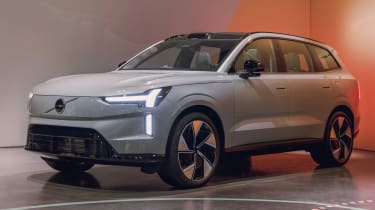
Volvo EX90
The zero-emissions replacement for Volvo's flagship seven-seat XC90 has been a long time coming, but the all-new, all-electric EX90 SUV has now been unveiled and will go on sale in late 2023. The EX90 uses the same platform and running gear as the Polestar 3, which means every model is powered by a 107kWh usable battery that feeds two electric motors – one on each axle – for all-wheel drive. It also offers up to 364 miles of range at launch, 250kW rapid charging speeds, features a Google-powered infotainment system and seven seats. It is quite a bit more expensive than the petrol XC90, though; prices start from £96,255.
Recommended

Porsche Macan EV: BMW iX rival gets Taycan-inspired interior

MINI Cooper Electric: pricing and specs for British-built electric supermini
Most Popular

MINI Cooper Electric: pricing and specs for British-built electric supermini

Morgan Super3 XP-1 is an electric three-wheeler
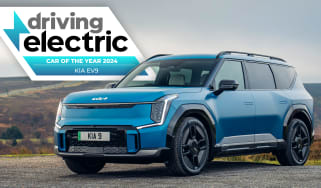
The Kia EV9 is DrivingElectric Car of the Year 2024

